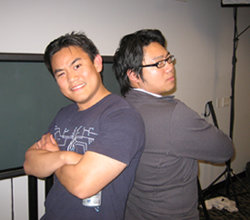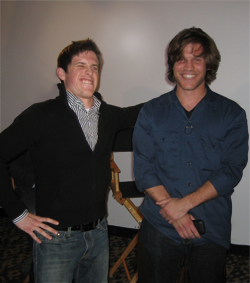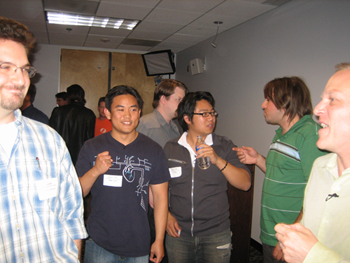April Game Deconstruction Group Examines Resident Evil 5 & Afro Samurai
4/16/2009

The Game Deconstruction Group examines the most critically and commercially acclaimed video games in order to answer the question: what makes great games great? The most recent gathering of the group on April 16, 2009 was very special. Hosted by G4 Media, Inc. and moderated by Adam Sessler, game makers gathered to discuss the newest installment in Capcom's hugely successful survival horror series Resident Evil 5, as well as the hack-and-slash release of the popular made-for-America anime Afro Samurai. The attendees, consisting of designers, artists, programmers, and producers from game companies across Southern California, shared their insights on the two games during an evening of food, laughter, and good-natured debate. USC Game Design students Al Yang and Kyle Fujita began the evening's presentation with a comprehensive analysis of Resident Evil 5's gameplay, cinematic direction, use of interactive "quick-time" events, out-door daylight setting, and the addition of a co-operative story campaign and multiplayer versus mode; the first of its kind for a series that had traditionally thrived on solo white-knuckle thrills and scares.
USC Game Design students Al Yang and Kyle Fujita began the evening's presentation with a comprehensive analysis of Resident Evil 5's gameplay, cinematic direction, use of interactive "quick-time" events, out-door daylight setting, and the addition of a co-operative story campaign and multiplayer versus mode; the first of its kind for a series that had traditionally thrived on solo white-knuckle thrills and scares.
The majority of the evening's discussion centered around what genre best describes the new Resident Evil. With the addition of arcade and action game elements such as a post-mission weapon marketplace, a cover system, a mini map HUD that tracks enemy movements in real time, and an online multiplayer component centered around combating people rather than monsters - as well as the omission of survival horror mainstays such as urgent resource management, a claustrophobic and dark environment, and the constant tension that no one is watching your back, the attendees of the Game Deconstruction Group pondered about how the game should be classified. Is it action? Is it survival horror? The group discussed in great detail what the defining characteristics of each genre were, and how this sudden shift in the series' tone has affected the expectations of its fans. The evening concluded with a sidebar presentation of the action hack-and-slash Afro Samurai, led by Blade Olson and Logan Olson.
The evening concluded with a sidebar presentation of the action hack-and-slash Afro Samurai, led by Blade Olson and Logan Olson.
The brief but detailed presentation included a thorough analysis of the game's use of "cues" to provide the player with information ranging from their character's health and combat readiness, to the introduction of new opponents and challenges, to the incorporation of cinematic storytelling cutscenes woven into the fabric of the gameplay. A discussion came up over "video game literacy" - how equipped casual gamers may be to interpret these kinds of signals in comparison to more avid video game players - and the importance of proper communication and "player training" when setting up the first stages of an interactive experience.
Presenters Blade and Logan also described the distinction between adaptations and recreations of existing material, and the evening's attendees discussed the real world rammifications of departing from source material to tell a story different than what fans may be familiar with.
The Academy once again extends its thanks to the USC game design students for their informative and detailed presentations, and to the attendees for their insights, enthusiasm, and participation.
A copy of the students' presentations is available upon request. To request a copy of the presentations, or to be added to the Game Deconstruction Group mailing list, please contact Terrence Myers.
